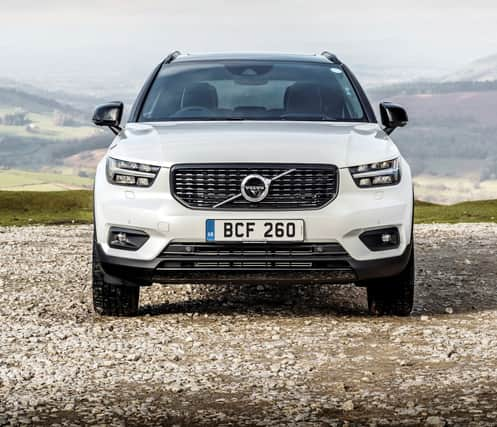A typical Scandinavian lack of fuss...


The Swedish premium brand was shrewd in making its biggest-selling vehicle — the XC40 SUV — its first fully electric product and this month saw the global launch of its new C40 crossover, its first electric-only model.
But as the drive to pure EV propulsion gathers pace, many industry experts suggest a plug-in hybrid (PHEV) is still the best stepping-stone to zero emissions for the average motorist.
Advertisement
Hide AdAdvertisement
Hide AdWith this in mind I took a back-to-back look at the XC40 Recharge T4 PHEV and its all-electric stablemate, the XC40 Recharge Twin.
The first and most obvious difference is the starting price.
Where the XC40 PHEV line-up starts at £37,345, the EV starts at £49,950.
There are specification differences to help justify the uplift in price, with the EV — defined by its plastic-covered grille — wearing 19-inch alloys as standard, compared to the basic PHEVs 17s.
Advertisement
Hide AdAdvertisement
Hide AdThe EV also features Volvo’s latest Google-powered infotainment system, albeit through the same nine-inch portrait-orientated touchscreen, which works a lot better than the swipe-and-prod heavy previous incarnation in the PHEV.
As we’ve come to expect from Volvo, the interior of its XC40 — its smallest SUV — is very well appointed and feels a distinct step-up from more mainstream-leaning premium brands like Volkswagen and Peugeot.
Present and correct is the little Swedish flag attached to the shoulder portion of the driver’s seat, too, a show of pride in a product which oozes simple, fuss-free Scandinavian quality.
The crisp graphics of the 12-inch instrument binnacle are a joy to look at, although rather unusually for an EV offered no range read-out, preferring only to impart the percentage of charge remaining.
Advertisement
Hide AdAdvertisement
Hide AdVolvo claims that the Recharge Twin will cover 259 miles from the 78kWh lithium ion battery pack which feeds electricity into motors at the front and rear to deliver all-wheel-drive propulsion.
Unsurprisingly it’s this electric drivetrain that defined my time behind the wheel of the Recharge Twin, but I was surprised by how much.
Setting off in the Recharge Twin is a process that feeds into the Swedish drive for simplicity.
A keyless entry is followed by a starting process which requires no key-turning or button pressing.
Advertisement
Hide AdAdvertisement
Hide AdAs in VW’s ID models, it’s simply a case of selecting “Drive” and getting on your way.
And get on your way you will… rapidly. Simply put, this is the most potent Volvo I’ve ever driven.
Delivering 408PS and a thumping 660Nm of torque, the Recharge Twin can reach 62mph in a fairly eye-watering 4.9 seconds on its way to a comparatively modest 112mph top speed.
The unassuming SUV has the ability to seriously embarrass some very rapid road cars.
Advertisement
Hide AdAdvertisement
Hide AdAnd it actually handles too. Volvo might not have a reputation for dynamic prowess, but the Recharge Twin serves up awesome levels of traction and will point its nose tighter into a bend, adding attitude to its stance, under the application of power.
By comparison, the PHEV feels far more conventional, but could deliver the perfect balance of EV potential and range anxiety-relieving for some potential owners.
A 25.6 to 28-mile quoted all-electric range comes hand-in-hand with fuel economy of between 112.8mpg and 134.5mpg on the combined cycle.
This figure is a quirk of the test regime, however.
Use electric power all the time, on shorter journeys, and you are emissions-free.
Advertisement
Hide AdAdvertisement
Hide AdLeave the 10.6kWh battery uncharged and run the Recharge T4 running as a standard hybrid and you are likely to see miles-per-gallon in the mid-30s.
Either way, the PHEV remains a reasonably strong option for company car drivers thanks to a 13 per cent benefit-in-kind (BIK) tax bracket.
What it will not do — that the EV does so well — is stand the hairs up on the back of your neck when you plant the throttle.
In Recharge T4 guise (there is a more powerful T5 PHEV offering 180PS) the XC40 serves up 129PS and 245Nm of torque.
Advertisement
Hide AdAdvertisement
Hide AdThat will get it to 62mph in 8.5 seconds and on to a top speed of 112mph.
Performance is strongest with some charge on board, however, when the extra urge served up by the batteries reduces the loads placed on Volvo’s 1.5-litre, three-cylinder turbocharged petrol engine.
The engine noise is never more than a distant thrum, however.
I also found that the PHEV rode better than the EV.
Whether this is mainly due to a need to be able to handle the EV drivetrain’s extra power, to reign-in the 2,113kg kerb weight (versus 1,741kg for the PHEV), or simply those larger allow wheels, I’m not sure.
Advertisement
Hide AdAdvertisement
Hide AdIn summary, while both XC40s I drove over the space of a fortnight recently shared Volvo’s excellent practicality and build quality, they proved very different cars.
The EV, more expensive, premium feeling and staggeringly rapid, the PHEV comfortable, familiar and happily stress-free.
The choice is yours, but whichever way you choose to go, Volvo serves up its drivetrains with a typically Scandinavian lack of fuss…